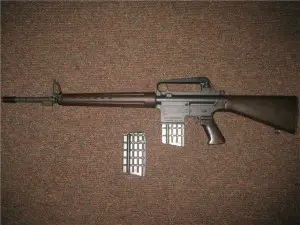 Alas, no new photos yet, but we have seen the AR-10 that we mentioned before, and it’s really nice. Photos soon, and a range trip, insha’allah. For the time being, here’s one of the auction shots to hold you. (A single click is your embiggenator).
Alas, no new photos yet, but we have seen the AR-10 that we mentioned before, and it’s really nice. Photos soon, and a range trip, insha’allah. For the time being, here’s one of the auction shots to hold you. (A single click is your embiggenator).
We’ve discovered just how rare these things are: less than 1,600 Portuguese AR-10s were made, all in 1960. Because of American gun laws and the ATF’s regulatory import ban, the ones that were imported were imported primarily as NFA Dealer Samples or — like this one — as parts kits, then mated up with new-manufacture receivers. It’s unlikely that there were more than a few hundred made in all, by at least three makers of lower receivers; and due to the ATF’s subsequent extension of the ban to barrels, it’s unlikely any more of the parts kits or firearms will be imported.
Here’s the original auction for this one, which will remain on the net for a short while.
Handling the weapon, there are a ton of differences between it at the modern AR-15-based AR-10s, some of which favor each weapon.
 In the meatime, an even nicer one, in the Sudanese variant, came up on GunBroker — and sold for $5,250. Yowza. The Portuguese one we have to examine is not as minty, and has replacement wood furniture, but it changed hands for a little over half that.
In the meatime, an even nicer one, in the Sudanese variant, came up on GunBroker — and sold for $5,250. Yowza. The Portuguese one we have to examine is not as minty, and has replacement wood furniture, but it changed hands for a little over half that.
It’s the first one that’s always cheap and easy, like your first hit from the neighborhood crack dealer. It’s when can’t stop yourself from upgrading the collection that it destroys your finances and your life and you wind up living in a Kelvinator box under a highway overpass — with no money, personal hygiene, or teeth, but with one of each variant of the gun.
The AR-10, though, is an unusually seminal gun. It did not see a lot of combat use, but where it did — in Portugal’s colonial wars of the seventies, and in some Castro-sponsored insurgencies like the one in the Dominican Republic — it made its mark. That was not its real “mark,” though, however much Portuguese paratroopers and European mercenaries on both sides of Third World Wars of “Liberation” may have loved it. More important was its position as the combat proof of concept for a weapon made of aerospace alloy forgings and molded composites, as the stealthy point man for the mass invasion of AR-15s, M16s, and M4s and all their cousins that would follow.

Kevin was a former Special Forces weapons man (MOS 18B, before the 18 series, 11B with Skill Qualification Indicator of S). His focus was on weapons: their history, effects and employment. He started WeaponsMan.com in 2011 and operated it until he passed away in 2017. His work is being preserved here at the request of his family.
